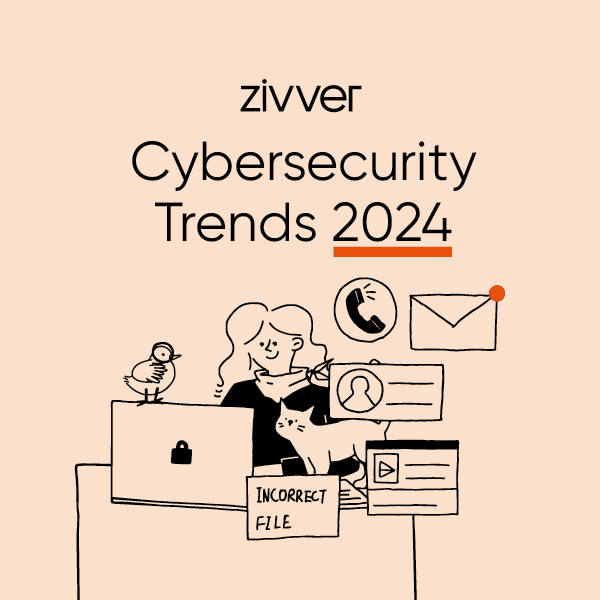According to the latest data, over 45,000 data incidents have been reported to the ICO since 2019. Of these, a huge 75% are the result of non-cyber related causes - incidents for which there is no clear link to a malicious cause.
This is not new or surprising information. We know that email and communication platforms remain the largest risk vectors, and employees continue to make mistakes when managing sensitive data.
In 2024, security will be considered a tactic for success, rather than an afterthought. To combat risks and fortify areas of weakness, security must be embedded into every individual and team strategy. But that isn’t to say that security should come between people and productivity.
.gif?width=650&height=650&name=Bar-Chart-1200x1200px%20(1).gif) Source: ico.org.uk/action-weve-taken/data-security-incident-trends/
Source: ico.org.uk/action-weve-taken/data-security-incident-trends/
The world of security has moved on from compulsory awareness training. Traditional security policies gather dust while people navigate restrictive guidance on the do’s and don’ts of sharing sensitive information with their stakeholders. IT teams are losing confidence in people to behave securely; people are losing patience with non-user friendly tech.
2024 will see cybersecurity become a collaborative effort for many progressive organizations. In order to keep up with the evolving security landscape and protect the security of their digital infrastructure, (think the development of AI and LLM, issues of interoperable tech, restrictive budgets etc), security and compliance leaders must bring every employee along on the security journey.
It’s time for change.
Read on to investigate how the cybersecurity landscape is evolving for the better, with insights from security leaders on:
- Who is ultimately responsible for an organisation’s security
- How to build a collaborative culture around compliance
- Building risk-centric strategies tailored to employee needs
- The role of technology in meeting evolving compliance laws
- How to measure the success of security training
Trend one: Giving control back to IT leaders
Adam Low | Chief Technology Officer
In an era in which IT and data security risks are escalating in breadth and scale, the role of IT security leaders has never been more critical. The landscape of IT security is rapidly evolving, compounded by the proliferation of IT systems, applications, and tools. One challenge I regularly hear from security and IT leaders is their inability to be in one hundred places at once. They cannot oversee the use of all applications, overlook every employee’s shoulder, or keep an eye on all the potential inbound or outbound security risks to pose a threat to their organization, whether malicious or on the inside. This expansion has created a hotspot for malicious actors who increasingly target employees as gateways into organizational systems.
And so the pressure on IT security leaders is immense. With the threat landscape expanding at an unprecedented rate, the task of safeguarding data and systems has become increasingly daunting. This challenge, though formidable, is a testament to the critical role these leaders play in our digital world, and the need for control over their cybersecurity strategies.
More platforms, more problems
However, our current approach to IT security is not without its pitfalls. Research indicates that employees often feel burdened by security processes, fostering a culture of fear, blame, and disrupted workflows. According to our findings, the most significant barriers to work employees face include excessive bureaucracy (41%), time-consuming security protocols (27%), and the complexity of multiple IT systems (26%).
.gif?width=650&height=650&name=Pie-Chart-1200x1200px%20(1).gif)
And, when employees feel hindered by tech, often they seek out alternative (less secure) ways of working, turning to non-compliant and unsecure communications platforms. In fact, a startling revelation from a recent Gartner report shows that 64% of employees routinely bypass security measures, with 9% acknowledging the heightened risk this poses to their organizations. This behavior underscores a disconnect between security policies and practical workflow integration.
During a recent industry debate, we questioned the notion of universal accountability for security. The consensus? While everyone bears some responsibility, simply delegating this accountability without proper support and tools is a recipe for failure.
People will inform the procedures
In 2024, security leaders must lead their organizations in the adoption of a more collaborative approach. By involving employees in the creation and review of security policies, we can improve both the practicality and adherence to these controls. Engaging employees to understand specific risks in their areas of work fosters a culture of mutual respect and shared responsibility.
Key to this is secure, user-friendly tools that cater to both usability and security needs. This approach not only enhances security but also reduces the likelihood of employees resorting to unsecured alternatives.
It's essential to maintain a balance between empowering employees and retaining the core responsibility of the security team. Establishing channels for ongoing feedback on security policies and tools allows for adaptability in the face of evolving security challenges.
In conclusion, transforming our approach from imposing rules to fostering a collaborative environment can significantly enhance our IT security posture in 2024. By treating employees as allies and equipping them with the necessary tools and knowledge, we can create a more robust, security-conscious culture. In this evolving digital landscape, collaboration is not just beneficial—it's essential for the future of IT security.
Key takeaways:
-
Security is not a one-man game - nor is it a one team game. Collaboration is key: security leaders must foster an organization-wide security culture with buy-in from exec-level down
-
Finger-pointing gets you nowhere. Employees are not threats to be mitigated; they are your greatest line of defense and must be empowered as such
-
Acknowledge the vital role of tech in your security posture. A focus on cohesion between people, processes and technology will support IT teams in identifying and preventing threats
Trend two: Striking the balance between risk-centric strategies and employee-centric solutions
Anita Mavridis, Vice President of Product
Information is the lifeblood of businesses, serving as both our most valuable asset and our most significant liability.
Human error remains the leading cause of data incidents - this is no secret. This harsh reality not only compromises sensitive information but also leads to a growing rift between IT leaders, employees, and data protection practices. The result? Inflated technology stacks, excessive spending, and dissatisfied employees.
The real question is, how can organizations manage their technology investments to maximize value, minimize risks, and bridge the gap between employees and IT leaders? The answer lies in truly understanding the ‘why’, aligning your technology with the 'how’, and understanding your ROI.
Let’s dig a little deeper.
The why: Risk-centric strategy
To truly empower efficiency and security, organizations must adopt a risk-centric approach. By identifying the primary risk vectors, organizations can focus their security strategy and allocate resources where they are most needed. Start with the 'why' – understand why your data protection measures exist and what you need to protect.
The how: Employee-centric solutions
According to Gartner, by 2027 50% of large enterprise CISOs will adopt human-centric security design practices. Empowering efficiency involves acknowledging your employees' needs, understanding the data they handle, and their business processes. In practice, this means selecting security solutions that enhance the user experience, not hinder it.
A security solution is only as strong as its user adoption. In a world where remote work is prevalent, a frictionless, user-friendly experience is critical to prevent shadow IT, ensure compliance, and protect your reputation.
Calculating ROI of security measures
Adopting technology is a significant financial investment, and now more than ever, IT leaders must justify these expenditures. Unlike some investments where the returns are easily quantifiable, the benefits of security solutions often involve intangible aspects such as reduced risk, enhanced reputation, and increased customer trust. These can be challenging to translate into concrete financial metrics.
Do yourself a favour and invest in security solutions that offer actionable insights enabling you to monitor the impact of your investment, and continuously assess whether they are delivering the expected value. Regular audits and feedback loops are essential for ensuring your tech stack aligns with the ‘why’.
In conclusion, the road to empowering efficiency and ROI in data protection starts with understanding the 'why' and proceeds with aligning your technology with the 'how.' By focusing on risk vectors, prioritizing employee needs, and measuring ROI, organizations can create a harmonious environment where technology and security solutions truly empower people.
Key takeaways:
- Quantifying the value of your cybersecurity investments incorporates intangible aspects of your business, including reputation, employee satisfaction and stakeholders. Implementing solutions which provide actionable insights on risks avoided helps IT leaders to communicate the value of investments to the wider business
- Adopting a risk-centric approach ensures investments are centered around the needs of the user
- User-adoption is integral; understanding employee needs will ensure technologies meet those needs
Trend three: Security is a team sport in 2024
Nadine Hoogerwerf, Chief Information Security Officer
2024 promises to be an interesting year for cybersecurity and compliance. Developments that have been ongoing for a while will continue to drive cybersecurity risk and work in the coming year and beyond. The amount of risks to manage and work to do requires an ‘all hands on deck’ approach toward security.
Security regulations promote better security
The EU is clearly on a mission to upgrade cybersecurity from a nice to have to a must have for more organizations and governments. The NIS2 is applicable to a broad range of sectors and sets out minimum standards for security for organizations and EU member states. It is promoting both preventive and responsive measures and pays specific attention to security around communication and ICT products. An extra incentive for organizations to act on this is the personal liability:
“Member States shall ensure that it is possible to hold such natural persons liable for breach of their duties to ensure compliance with this Directive” (Article 32.6)
In addition to the NIS 2, the EU has worked on more specific legislation such as DORA, targeting IT risk management in the financial sector, and the Digital Service Act that aims to protect the rights of users of online services.
Of course, data protection professionals and their organizations must support these developments; it is critically important that sensitive information and processes are sufficiently protected against harm, abuse and unfortunate mistakes.
However, this development poses a challenge for many in the cyber security field who are already struggling on a daily basis to identify what to prioritize.
Yes, compliance with legislation and regulation are important because non-compliance may harm your business and/or lead to formal warnings and fines. Furthermore, focussing on compliance can be an effective way to improve security.
Emerging technologies demand security attention
Still, compliance does not equal security. Cybersecurity teams should give attention to other developments, too. New technologies have been introduced (and are expected on the horizon) that will impact security significantly.
Take, for instance, AI technologies; these can be used by hackers to improve their phishing emails or scripts, making the ‘job of a hacker’ less dependent on skills. In addition, quantum computers are expected to be able to break several encryption algorithms that are frequently used nowadays, and are expected on the market within 10 years.
But, if we are being honest, it is not just new technologies that need security. Many existing technologies could still use a security upgrade in most organizations: the ‘internet of things’, web applications, email - the most common platforms and the most common risk vectors.
All hands on deck
In order to cover it all, security professionals should empower the whole organization to get security right. The time security was done by a few individuals tucked away in an office somewhere is over. Security should be part of everyone’s job and on everyone’s mind.
The security team should focus on enabling their colleagues to easily add security to their jobs. For example by providing code scanning tooling that can be executed by developers themselves before releasing their new code and software that can detect potential data leaks before they happen.
In addition it is key to install a tiny bit of security paranoia and a lot of security wisdom in your whole team. By awareness activities and by close collaboration with the security team everyone should be enabled and inspired to become a ‘risk spotter’ and a wise decision maker when it comes to security risk. Don’t see the team as a liability, but as the security team's eyes and ears.
Key takeaways:
- Compliance doesn’t equal security
- Some of our most frequently used platforms require security advancements to make them compliant - this should be a priority for every organisation for 2024
- Compliance cannot be the responsibility of one team or individual; it is a company-wide priority for which everyone is responsible to some degree
Trend four: Harmonizing training and tech to build a security minded culture
Rick Goud | Chief Innovation Officer
Organisations continue to invest thousands every year into training activities; compulsory courses, videos, quizzes… But how do you know whether your security training is delivering value?
The delivery sometimes changes but the results rarely do. Employees may temporarily change their ways, but their behavior in the long term remains the same.
But that isn’t to say that people intentionally ignore or forget their learnings. The issue is that training, in both its content and delivery, rarely meets the needs of people.
.gif?width=650&height=650&name=3-Pie-Charts-1200x1200px%20(1).gif)
A new measurement for training success
For many organisations, training continues to be treated as a tick-in-the-box exercise for meeting their responsibilities under data protection regulations. Often, little thought is put into the real purpose of training or the measurability of its success. In most cases, the actual delivery of training is considered the success metric: did all employees complete the training? Yes. Success.
However, if security incidents continue to happen, training must be challenged, not people. And this is the take away for 2024. Success must be measured on the success of people - not the delivery of training itself.
Human error remains the leading cause of data incidents. These incidents happen quickly, with an accidental click in the midst of a busy moment. Employees want actionable decision support at the moment where it matters to empower them to work efficiently and securely. This includes lessons on how to avoid landing themselves - and their organisations - in hot water. Making employees aware of the most prominent security risks they will face every day (such as how to use bcc properly, when to encrypt data, or how to share sensitive information compliantly) is a step in the right direction in ensuring training truly meets the needs of people.
Delivery of training
A one size fits all approach to training doesn’t work. Across your organisation, employees have different responsibilities, priorities and stakeholders. They use different systems and have access to different data sets. Naturally, for every team and individual, the risk factors are different.
Training must be tailored to the individual. But exactly how practical is this?
Rather than taking a siloed approach with periodic training moments, progressive organizations are collating their resources and technology to deliver in-the-moment decision support for employees. Harnessing behavioral insights and intuitive technology, organizations can empower their people to work securely supported by in-the-moment threat and error prevention, and security best practice.
This approach, combining technology and knowledge sharing, delivers measurable security training for every employee, without impacting existing workflows or interfering with busy schedules.
In addition to the end-user benefit, targeted training supports security leaders to learn from their people. Identifying risk enables you to prevent data breaches, enhancing security in the vulnerable areas.
Your security training should do more than support people to identify phishing emails. It should drive your organization to adopt a sustainable data-driven security posture, in which every employee is empowered to work securely and with confidence.
Key takeaways:
- The success of a security training programme should directly correspond to the employee’s success in preventing data loss events
- Training cannot be just delivered once or twice a year in the form of quizzes or videos; it must be supplemented with or partly replaced by in-the-moment decision support to truly have an impact
- Training should give more to your organisation than a tick in the box on the matter of compliance; it should enforce a security culture powered by insights into employee behaviour
Ready to learn more?
Download the Cybersecurity Trends Report 2024




